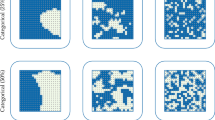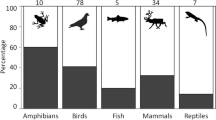Abstract
Spatial capture–recapture (SCR) models are a relatively recent development in quantitative ecology, and they are becoming widely used to model density in studies of animal populations using camera traps, DNA sampling and other methods which produce spatially explicit individual encounter information. One of the core assumptions of SCR models is that individuals possess home ranges that are spatially stationary during the sampling period. For many species, this assumption is unlikely to be met and, even for species that are typically territorial, individuals may disperse or exhibit transience at some life stages. In this paper we first conduct a simulation study to evaluate the robustness of estimators of density under ordinary SCR models when dispersal or transience is present in the population. Then, using both simulated and real data, we demonstrate that such models can easily be described in the BUGS language providing a practical framework for their analysis, which allows us to evaluate movement dynamics of species using capture–recapture data. We find that while estimators of density are extremely robust, even to pathological levels of movement (e.g., complete transience), the estimator of the spatial scale parameter of the encounter probability model is confounded with the dispersal/transience scale parameter. Thus, use of ordinary SCR models to make inferences about density is feasible, but interpretation of SCR model parameters in relation to movement should be avoided. Instead, when movement dynamics are of interest, such dynamics should be parameterized explicitly in the model.



Similar content being viewed by others
Notes
This compares to estimates of home range size derived from telemetry at a different site in New York (over a longer time period) of 155–253 km\(^2\) for males and 36 km\(^2\) for females.
References
Arnason AN (1973) The estimation of population size, migration rates and survival in a stratified population. Res Popul Ecol 15:1–8
Belda EJ, Barba E, Monros JS (2007) Resident and transient dynamics, site fidelity and survival in wintering Blackcaps Sylvia atricapilla: evidence from capture–recapture analyses. Ibis 149:396–404
Borchers DL (2012) A non-technical overview of spatially explicit capture–recapture models. J Ornithol 152:435–444
Borchers DL, Efford MG (2008) Spatially explicit maximum likelihood methods for capture–recapture studies. Biometrics 64:377–385
Borchers DL, Distiller G, Foster R, Harmsen B, Milazzo L (2014) Continuous-time spatially explicit capture–recapture models, with an application to a jaguar camera-trap survey. Methods Ecol Evol 5:656–665
Borger L, Dalziel BD, Fryxell JM (2008) Are there general mechanisms of animal home range behavior? A review and prospects for future research. Ecol Lett 11:637–650
Brooks S, Gelman A (1998) General methods for monitoring convergence of iterative simulations. J Comput Graph Stat 7:434–455
Caro TM (1994) Cheetahs of the Serengeti Plains: group living of an asocial species. University of Chicago press, Chicago
Chandler RB, Royle JA (2013) Spatially explicit models for inference about density in unmarked or partially marked populations. Ann Appl Stat 7:936–954
Chandler RB, Clark JD (2014) Spatially explicit integrated population models. Methods Ecol Evol 5:1351–1360
Clobert J, Baguette M, Benton TG, Bullock JM, Ducatez S (eds) (2012) Dispersal ecology and evolution. Oxford University Press, Oxford
Constantine R, Jackson JA, Steel D, Baker CS, Brooks L, Burns D, Clapham P, Hauser N, Madon B, Mattila D, Oremus M, Poole M, Robbins J, Thompson K, Garrigue C (2012) Abundance of humpback whales in Oceania using photo-identification and microsatellite genoty**. Mar Ecol Prog Ser 453:249–261
Efford M (2004) Density estimation in live-trap** studies. Oikos 106:598–610
Efford MG, Dawson DK, Borchers DL (2009) Population density estimated from locations of individuals on a passive detector array. Ecology 90:2676–2682
Ergon T, Gardner B (2014) Separating mortality and emigration: modelling space use, dispersal and survival with robust-design spatial capture–recapture data. Methods Ecol Evol 5:1327–1336
Fuller AK, Harrison DJ (2005) Influence of partial timber harvesting on American martens in north-central Maine. J Wildl Manag 69:710–722
Fuller AK, Harrison DJ, Vashon JH (2007) Winter habitat selection by Canada lynx in Maine: prey abundance or accessibility? J Wildl Manag 71:1980–1986
Fuller AK, Sutherland CS, Royle JA, Hare MP (2015) Estimating population density and connectivity of American mink using spatial capture–recapture. Ecol Apps. doi:10.1890/15-0315.1
Gardner B, Royle JA, Wegan MT, Rainbolt RE, Curtis PD (2010) Estimating black bear density using DNA data from hair snares. J Wildl Manag 74:318–325
Gehrt SD, Anchor C, White LA (2009) Home range and landscape use of coyotes in a metropolitan landscape: conflict or coexistence? J Mammal 90:1045–1057
Hestbeck JB, Nichols JD, Malecki RA (1991) Estimates of movement and site fidelity using mark-resight data of wintering Canada geese. Ecology 72:523–533
Hines JE, Kendall WL, Nichols JD (2003) On the use of the robust design with transient capture–recapture models. The Auk 120:1151–1158
Kéry M, Schaub M (2012) Bayesian population analysis using WinBUGS–a hierarchical perspective. Academic Press, London
Moorcroft PR, Lewis MA, Crabtree RL (2006) Mechanistic home range models capture spatial patterns and dynamics of coyote territories in Yellowstone. Proc R Soc B Biol Sci 273(1594):1651–1659
Perret N, Pradel R, Miaud C, Grolet O, Joly P (2003) Transience, dispersal and survival rates in newt patchy populations. J Anim Ecol 72:567–575
Plummer M (2003) JAGS: a program for analysis of Bayesian graphical models using Gibbs sampling. In: Proceedings of the 3rd international workshop on distributed statistical computing, vol 124, p 125, Vienna
Pradel R, Hines JE, Lebreton JD, Nichols JD (1997) Capture–recapture survival models taking account of transients. Biometrics 53:60–72
Rohner C (1997) Non-territorial ‘floaters’ in great horned owls: space use during a cyclic peak of snowshoe hares. Anim Behav 53:901–912
Royle JA, Young KV (2008) A hierarchical model for spatial capture–recapture data. Ecology 89:2281–2289
Royle JA, Dorazio RM, Link WA (2007) Analysis of multinomial models with unknown index using data augmentation. J Comput Graph Stat 16:67–85
Royle JA, Chandler RB, Sun CC, Fuller AK (2013a) Integrating resource selection information with spatial capture–recapture. Methods Ecol Evol 4:520–530
Royle JA, Chandler RB, Gazenski KD, Graves TA (2013b) Spatial capture–recapture models for jointly estimating population density and landscape connectivity. Ecology 94:287–294
Royle JA, Chandler RB, Sollmann R, Gardner B (2014) Spatial capture–recapture. Academic Press, London
Royle JA, Sutherland C, Fuller AK, Sun CC (2015) Likelihood analysis of spatial capture–recapture models for stratified or class structured populations. Ecosphere 6:art22
Saracco JF, Royle JA, DeSante DF, Gardner B (2010) Modeling spatial variation in avian survival and residency probabilities. Ecology 91:1885–1891
Sasso CR, Braun-McNeill J, Avens L, Epperly SP (2006) Effects of transients on estimating survival and population growth in juvenile loggerhead turtles. Mar Ecol Prog Ser 324:287–292
Schaub M, Royle JA (2014) Estimating true instead of apparent survival using spatial Cormack–Jolly–Seber models. Methods Ecol Evol 5:1316–1326
Sollmann R, Gardner B, Parsons AW, Stocking JJ, McClintock BT, Simons TR, Pollock KH, O’Connell AF (2013) A spatial mark-resight model augmented with telemetry data. Ecology 94:553–559
Sutherland C, Elston DA, Lambin X (2013) Accounting for false positive detection error induced by transient individuals. Wildl Res 40:490–498
Sutherland C, Fuller AK, Royle JA (2015) Modelling non-Euclidean movement and landscape connectivity in highly structured ecological networks. Methods Ecol Evol 6:169–177
Tufto J, Lande R, Rignsby TH, Engen S, Saether BE, Walla TR, DeVries PJ (2012) Estimating Brownian motion dispersal rate, longevity and population density from spatially explicit mark-recapture data on tropical butterflies. J Anim Ecol 81:756–769
Acknowledgments
Preliminary results of this research were presented by the authors at the 2014 Graybill/ENVR Conference: Modern Statistical Methods for Ecology, held September 7–10, 2014 at Colorado State University, Fort Collins, Colorado. We thank Michael Schaub and 2 anonymous referees for their thoughtful reviews of the manuscript. Part of this research was performed using the ATLAS HPC Cluster, a compute cluster with 672 cores, 4 Tesla M2090 GPU accelerators, supported by NSF grants (Award # 1059284 and 0832782).
Author information
Authors and Affiliations
Corresponding author
Electronic supplementary material
Below is the link to the electronic supplementary material.
Rights and permissions
About this article
Cite this article
Royle, J.A., Fuller, A.K. & Sutherland, C. Spatial capture–recapture models allowing Markovian transience or dispersal. Popul Ecol 58, 53–62 (2016). https://doi.org/10.1007/s10144-015-0524-z
Received:
Accepted:
Published:
Issue Date:
DOI: https://doi.org/10.1007/s10144-015-0524-z




